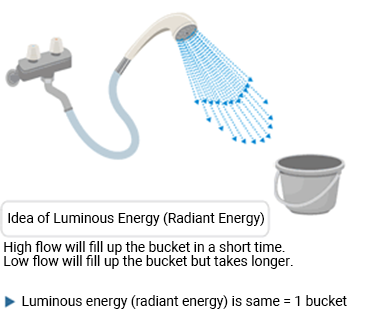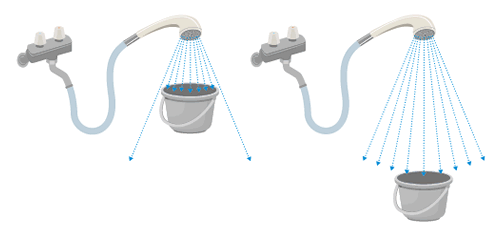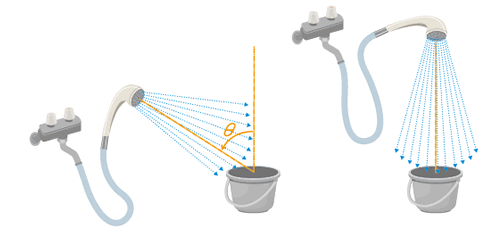Theory of Light and Color

6. Radiant Quantities and Luminous Quantities (Part 3)
Variations in the Definition of Brightness
Up until this point, we have explained brightness and darkness from a spectroscopic perspective of how much stimulus a light detector (human eye or machine eye) receives from the light source. However, there are other factors to consider when you talk about brightness. For example, the brightness experienced when working at a desk is different from that experienced from a TV screen or a traffic light. Therefore, we must measure them differently: the former by illuminance and the latter by luminance.

Measuring Brightness Under Different Geometric Conditions
The illuminance and luminance referred to here are different from the spectroscopic factors like the human eye and machine eye and differ by geometric conditions such as direction, angle, and area. This section covers the different types of luminous, radiant, and sensor-metric quantities ≪1≫ based on geometric conditions.
The first way to define brightness is by spectroscopic characteristics: divided into luminous quantities and radiant quantities (and sensor-metric quantities). As we have discussed, measures of luminous quantities (illuminance and luminance, etc.) correlate with the human eye’s perception of brightness. This spectroscopic condition is different when measuring radiant quantities (irradiance and radiance) and sensor-metric quantities, but all three have similar geometric conditions. These spectroscopic and geometric conditions define various luminous quantities and radiant quantities, including
- ● luminous flux/radiant flux
- ● luminous energy/radiant energy
- ● illuminance/irradiance
- ● luminous exitance/radiant exitance
- ● luminous intensity/radiant intensity
- ● luminance/radiance
In machine vision, you must understand the distinctions between these spectroscopic and geometric conditions when considering what light to use on a workpiece, as it can directly affect the quality of information extracted from an image.
| Classification of spectral conditions | |||
|---|---|---|---|
| Radiant Quantities (Electromagnetic Energy) |
Luminous Quantities (Human Eye) |
Sensor-metric Quantities (Machine Eye) |
|
| Classification on geometric conditions | Radiant Flux | Luminous Flux | Sensor-metric Flux |
| Radiant Energy | Luminous Energy (Quantity of Light) |
Quantity of Sensor-metric Light |
|
| Irradiance | Illuminance | Sensor-metric Illuminance | |
| Radiant Exitance | Luminous Exitance | Sensor-metric Exitance | |
| Radiant Intensity | Luminous Intensity | Sensor-metric Intensity | |
| Radiance | Luminance | Sensor-metric Luminance | |
Luminous Energy (Luminous Quantities) and Radiant Energy (Radiant Quantities)
The brightness experienced when turning on the light in a room refers to the degree of brightness or darkness, that is, the luminous energy (also called the quantity of light). Luminous energy is the perceived energy of light measured as the product of the luminous flux (lm) and time (sec), or (lm・sec). Returning to the example in Chapter 4 of a shower and a bucket, a shower with a strong flow will fill up the bucket in a short time. A weak shower flow will still fill up the bucket but takes longer. In each case, the water volume is for one bucket.
In machine vision, you can adjust this strength through a combination of the F-number of the lens and the exposure time (shutter speed) of the camera. When the F-number remains constant, you can adjust the brightness of the workpiece by shortening the exposure time (fast shutter speed) if it is too bright and lengthening the exposure time (slow shutter speed) if it is too dark. Thus, lights with different intensities can still achieve images of equal brightness by adjusting the F-number and the exposure time.

In a similar way, the relationship between radiant flux and radiant energy corresponds to that of luminous flux and luminous energy. The product of radiant flux (W) and time (sec) is radiant energy, measured in joules (J = W・sec).
Illuminance (Luminous Quantities) and Irradiance (Radiant Quantities)
Illuminance is the luminous flux incident to a surface per unit area (m2). It measures how much the incident light illuminates the surface. For instance, the brightness you see on a desk is illuminance. The unit of measure is (lm/m2), but for illuminance, lux (lx) is an equivalent measure.
Illuminance depends on the distance from the light source to the surface receiving the light ≪2≫ and the direction of the incident light. ≪3≫
Furthermore, it increases as the number of light sources increases. ≪4≫ In the shower and bucket example, the water that flows into the bucket’s area A (m2) corresponds to the illuminance. By opening the faucet more, you will strengthen the water flow to the bucket, meaning higher illuminance.
The relationship between radiant flux and irradiance is analogous to that of luminous flux and illuminance. Radiant flux (W), which is incident to the unit area (m2), is the irradiance measured in (W/m2).

Luminous Exitance (Luminous Quantities) and Radiant Exitance (Radiant Quantities)
Luminous exitance is similar in concept to illuminance. It is the total luminous flux (lm) emitted per unit area (m2) of the light source (lm/m2). Luminous exitance corresponds to the water that flows out from one specific area (area A (m2)) of the showerhead in all directions. Radiant flux and radiant exitance have a similar relationship as well. The radiant flux (W) emitted from the unit area (m2) equals radiant exitance (W/m2).

Relationship Between Illuminance and Luminous Exitance
As mentioned above, illuminance and luminous exitance have the same SI unit. Irradiance and radiant exitance also share the same unit of measure. Though luminous flux per unit area and radiant flux per unit area are similar concepts, these quantities differ from exitance quantities in the direction that light travels. Illuminance and irradiance measure flux traveling toward a surface. Luminous exitance and radiant exitance measure flux emitted from a surface.
Summary
In this section, we have described several luminous quantities and radiant quantities. The next section will go into more detail on two other types of luminous quantities and radiant quantities: luminous intensity and radiant intensity and luminance and radiance.
Comment
≪1≫ Sensor-metric Quantities
CCS Inc. uses the term sensor-metric quantities to measure the sensitivity of a sensor (machine eye). It is not a standard term within machine vision, but we will use it from this section.
≪2≫ Distance dependence of illuminance
The closer the distance between the showerhead and the bucket, the more water will flow into the bucket. In the case of light, the closer the light source (divergence), the higher the illuminance on that surface.

≪3≫ Oblique incident light properties: Incident angle dependence of illuminance
Compare how much water enters the bucket if the showerhead is directly above the bucket (the normal angle) versus at oblique angle θ. Less water enters the bucket from the oblique angle (if the distance between the showerhead and the bucket remains unchanged). In the case of light, illuminance decreases as the incident angle increases.

≪4≫ Illuminance additivity
Imagine adding another showerhead at a different angle θ2. The water streams from the two showerheads go into the bucket. That is, the illuminance increases with two light sources compared to only one.

Radiant Quantities and Luminous Quantities (Part 3)
Variations in the Definition of Brightness

